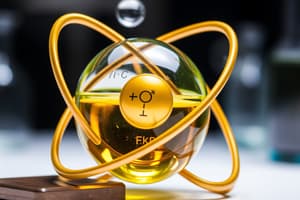Podcast
Questions and Answers
What is an atom?
What is an atom?
- A particle that cannot exist independently
- The smallest particle of an element that can retain its identity in a chemical reaction (correct)
- A negatively charged particle in the nucleus
- A chemical compound made of multiple elements
Who first suggested the idea of an atom and called it 'atomos'?
Who first suggested the idea of an atom and called it 'atomos'?
Democritus
Who discovered the electron?
Who discovered the electron?
J.J. Thomson
What is Dalton's Atomic Theory?
What is Dalton's Atomic Theory?
What does a scanning tunneling microscope do?
What does a scanning tunneling microscope do?
What are subatomic particles?
What are subatomic particles?
What is the charge of electrons?
What is the charge of electrons?
What is the charge of protons?
What is the charge of protons?
What is a neutron?
What is a neutron?
What is the plum-pudding model?
What is the plum-pudding model?
What was the outcome of the gold-foil experiment conducted by Ernest Rutherford?
What was the outcome of the gold-foil experiment conducted by Ernest Rutherford?
What is the atomic number?
What is the atomic number?
What does mass number refer to?
What does mass number refer to?
What is an isotope?
What is an isotope?
Atomic mass is a simple average of all isotopes of an element.
Atomic mass is a simple average of all isotopes of an element.
A ______ table is an arrangement of elements based on repeating properties.
A ______ table is an arrangement of elements based on repeating properties.
What defines the groups or families in the periodic table?
What defines the groups or families in the periodic table?
What is the function of the anode?
What is the function of the anode?
What is the function of the cathode?
What is the function of the cathode?
Flashcards
Atom
Atom
The smallest unit of an element that retains the chemical properties of that element. It's the building block of everything around us.
Democritus
Democritus
An ancient Greek philosopher who proposed the idea of atoms as indivisible particles, but lacked experimental evidence for his theory.
John Dalton
John Dalton
A scientist who developed the first atomic theory based on experimental observations, laying the foundation for modern atomic theory.
Dalton's Atomic Theory
Dalton's Atomic Theory
Signup and view all the flashcards
Scanning Tunneling Microscope
Scanning Tunneling Microscope
Signup and view all the flashcards
Subatomic particles
Subatomic particles
Signup and view all the flashcards
J.J. Thomson
J.J. Thomson
Signup and view all the flashcards
Robert A. Millikan
Robert A. Millikan
Signup and view all the flashcards
Eugen Goldstein
Eugen Goldstein
Signup and view all the flashcards
James Chadwick
James Chadwick
Signup and view all the flashcards
Thomson's Model
Thomson's Model
Signup and view all the flashcards
Ernest Rutherford
Ernest Rutherford
Signup and view all the flashcards
Atomic Number
Atomic Number
Signup and view all the flashcards
Mass Number
Mass Number
Signup and view all the flashcards
Nuclide
Nuclide
Signup and view all the flashcards
Atomic Mass
Atomic Mass
Signup and view all the flashcards
Isotopes
Isotopes
Signup and view all the flashcards
Atomic Mass Unit (amu)
Atomic Mass Unit (amu)
Signup and view all the flashcards
Periodic Table
Periodic Table
Signup and view all the flashcards
Periods
Periods
Signup and view all the flashcards
Groups/Families
Groups/Families
Signup and view all the flashcards
Study Notes
Atomic Structure
- Atoms are the basic units of elements, retaining their identity during chemical reactions.
Historical Contributors
- Democritus: Proposed the concept of the atom as indivisible ('atomos'), favoring philosophical thought over experimental science.
- John Dalton: Developed the first atomic theory detailing the nature of atoms, emphasizing that elements consist of indivisible particles and combine in fixed ratios during chemical reactions.
Dalton's Atomic Theory
- All matter consists of tiny, indivisible particles called atoms.
- Atoms of identical elements are the same, but differ from atoms of other elements.
- Atoms can mix physically or chemically combine in simple whole-number ratios to form compounds.
- Chemical reactions involve the separation, joining, or rearrangement of atoms; atoms cannot change into different elements.
Techniques and Discoveries
- Scanning Tunneling Microscope: Allows visualization of individual atoms through graphical imaging.
- Subatomic Particles: Atoms are composed of protons (positively charged), neutrons (neutral), and electrons (negatively charged).
- J.J. Thomson: Identified electrons using a cathode-ray tube, proving their existence.
- Robert A. Millikan: Measured the charge and calculated the mass of the electron (1/1840 of a hydrogen atom).
- Eugen Goldstein: Discovered protons.
- James Chadwick: Discovered neutrons.
Atomic Models
- Thomson's Model: Known as the "plum-pudding model," which described electrons embedded in a positive charge.
- Ernest Rutherford: Conducted the gold-foil experiment, establishing the existence of a dense nucleus within atoms. His model depicted electrons orbiting a central nucleus containing protons and neutrons.
Atomic Composition
- Atomic Number: Number of protons in an atom, defining the element.
- Mass Number: Total number of protons and neutrons in an atom.
- Nuclide: Representation for an individual isotope.
- Atomic Mass: Weighted average of an element's isotopes.
- Isotopes: Variants of elements with the same number of protons but different numbers of neutrons.
Measurement and Classification
- Atomic Mass Unit (amu): A unit based on 1/12 of a Carbon-12 atom, used for measuring atomic masses.
- Periodic Table: Organized array of elements grouped by properties, reflecting periodic trends.
- Periods: Horizontal rows where element properties vary across the table.
- Groups/Families: Vertical columns indicating elements with similar properties.
Studying That Suits You
Use AI to generate personalized quizzes and flashcards to suit your learning preferences.




